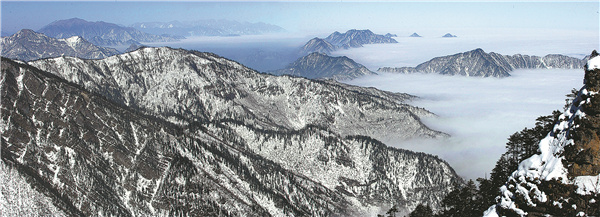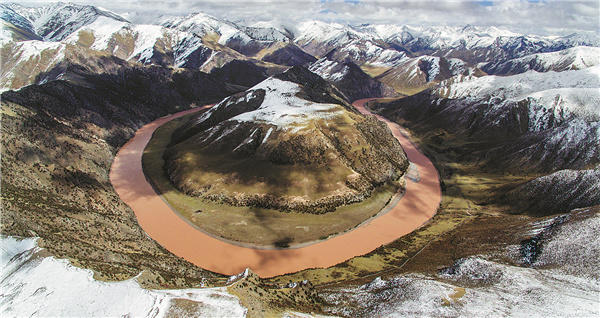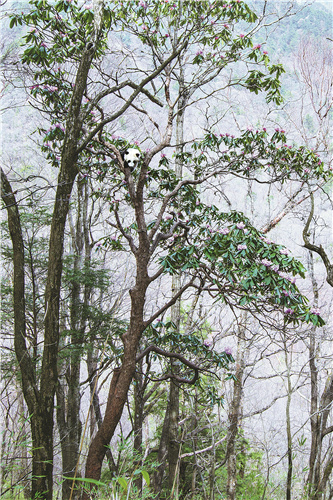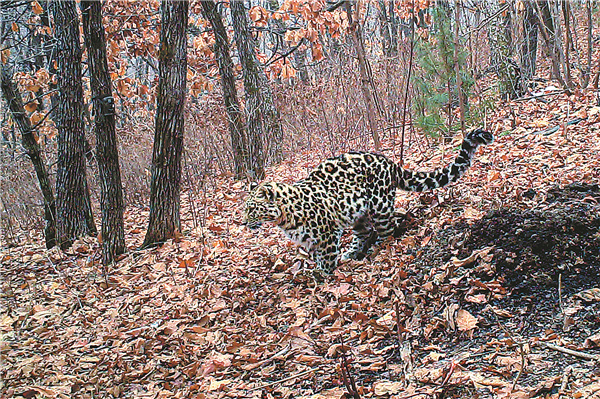
Giant panda habitat in Xiling Snow Mountain in Sichuan province. [Photo by Zhou Mengqi/For China Daily]
On Oct 12, when addressing the Leaders' Summit of the 15th meeting of the Conference of the Parties to the Convention on Biological Diversity, or COP 15, via video link, President Xi Jinping announced that China had officially designated its first group of national parks, including the Three-River-Source National Park, the Giant Panda National Park, and the Northeast China Tiger and Leopard National Park. The protected area of the five national parks is about 230,000 square kilometers, covering nearly 30 percent of the national key protected wildlife species on land.
In a move to enhance biodiversity conservation, China unveiled a guideline in October that includes wide-ranging measures, vowing to bring 77 percent of national key wildlife species under protection by 2025 with the help of cutting-edge technologies. China also aims to see its forest coverage rate increase to 24.1 percent and place 55 percent of its wetlands under protection by 2025. Forest coverage will be increased to 26 percent by 2030, when around 60 percent of wetlands will be protected.

In the Three-River-Source National Park, the Tongtian River, passing through Zhiduo county in Qinghai province, forms a straw-hat-shaped bend. The river is the main stream at the source of the Yangtze River with an average elevation of 4,300 meters. [Photo by Chen Jie/For China Daily]
The guideline underscored the importance of biodiversity protection work. In its efforts to cope with the challenges, China will expand its national parks, increase its forest areas and have more wetlands and natural coastlines protected. China will make 18 percent of its territory protected natural areas with the help of a system supported mainly by national parks by 2025. According to the National Forestry and Grassland Administration, the forest coverage rate in the country stood at roughly 23 percent at the end of last year, compared with only 8.6 percent in 1949. About 52 percent of the country's wetlands are being conserved.

In the Northeast China Tiger and Leopard National Park, chipmunks shelter from the rain under mushrooms. [Photo by Gu Baochen/For China Daily]
The guideline said the authorities will also ramp up the integration of databases for species and their genetic resources and promote the sharing of the information. The Northeast China Tiger and Leopard National Park established a space-ground integrated information network, which integrates a series of information technologies in January 2020 when the park was being piloted, according to the National Forestry and Grassland Administration. The guideline also stressed the establishment of a long-term, dynamic monitoring system, noting that the country will step up research and development on models for biodiversity forecasting and early warning to establish an emergency response mechanism.
Three-River-Source National Park
Located in the hinterland of the Qinghai-Tibet Plateau, it is the birthplace of the Yangtze River, the Yellow River, and the Lancang River. It is a veritable "water tower" and an important freshwater supply. It maintains the lifeline of water safety in the country and, to a large extent, in Asia. It is the most sensitive region in response to global climate change, and one of China's priority areas for biodiversity conservation.

In Wuyi Mountain National Park, short-tailed monkeys feed their babies. [Photo by Ruan Xueqing/For China Daily]
Giant Panda National Park
Straddling the three provinces of Sichuan, Shaanxi and Gansu, it is an important part of the national ecological security barrier "two screens and three belts". About 1,340 wild giant pandas live in the region, accounting for 58.48 percent of the country's total panda habitats.

A leopard in the Northeast China Tiger and Leopard National Park. [Photo by Gu Baochen/For China Daily]
Northeast China Tiger and Leopard National Park
Located in the southern Laoyeling area at the junction of Jilin and Heilongjiang provinces, it is one of China's most important habitats for tigers and leopards. It is also the largest settlement and breeding area for Siberian tigers and leopards.
Hainan Tropical Rainforest National Park
Located in the central mountainous area of Hainan Island, it is the most concentrated, most complete, best-preserved, and largest contiguous continental island tropical rainforest in China. It is the only global distribution area of Hainan Gibbon and a treasure house of tropical biodiversity.

A Panda cub plays in a blooming rhododendron tree in the Giant Panda National Park. [Photo by Pei Jingde/For China Daily]
Wuyi Mountain National Park
Located in the northern part of Fujian province, it preserves the most complete, typical, and largest area of the central subtropical native forest ecosystem at the same latitude in the world. It is also a gene bank for rare and endemic wild animals. It is known as the birds' paradise, kingdom of snakes and world of insects.














